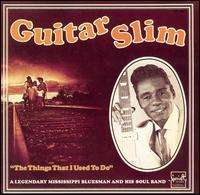The Things That I Used to Do
"The Things That I Used to Do" is a 12-bar blues song written by Guitar Slim. He recorded it in New Orleans, where the young Ray Charles arranged and produced the session. Specialty Records released the song as a single in 1953 and became a bestseller the following year. Specialty founder Art Rupe believed that the appeal would be limited to the Southern U.S. rural audience. However, urban rhythm and blues radio stations in the North began airing the song and built it into a national hit. As a result, Guitar Slim became in great demand as a performer and played at venues such as the Apollo Theater in New York City.
| "The Things That I Used to Do" | ||||
|---|---|---|---|---|
 | ||||
| Single by Guitar Slim | ||||
| B-side | "Well, I Done Got Over It" | |||
| Released | 1953 | |||
| Format | 7-inch single | |||
| Recorded | October 16, 1953 | |||
| Studio | Matassa's J&M Studio, New Orleans | |||
| Genre | ||||
| Length | 2:57 | |||
| Label | Specialty | |||
| Songwriter(s) | Eddie Jones a.k.a. Guitar Slim | |||
| Producer(s) | Ray Charles | |||
| Guitar Slim singles chronology | ||||
| ||||
| Audio sample | ||||
| ||||
The single was one of the biggest hits in Specialty's history and stayed on the Billboard's Rhythm and Blues Records charts for 42 weeks. The song remained at number one for six weeks and was the best-selling R&B record of the year, selling more than a million copies.[1]
Composition and recording
Charles's arrangement and piano accompaniment emphasize the religious tone of intense but philosophical regret in the singer's voice, giving the song a gospel-influenced feel. Like Fats Domino, Guitar Slim had a voice with a less adult sound than that of the typical blues shouters of the time, and his lyrics are less explicitly sexual.[2]
The song required numerous takes to record. Jones often stopped playing in the middle of the song for some reason, and they had to start from the beginning again. (Even in the take which was issued, Jones resumed the vocal after the instrumental chorus half a bar early, singing and playing two beats ahead of the band for the first eight bars of the final chorus.) During the song's fadeout Charles shouted "yeah!" as he realized that they had finally managed to make it to the end.
Influence and recognition
The Rock and Roll Hall of Fame included the tune on its list of the "500 Songs That Shaped Rock and Roll".[3] Stylistically, the song also contributed to the development of soul music.[4] In addition, the song was a success, influencing rock and roll by demonstrating the commercial success of using content that appeals to white listeners and by the effectiveness of its gospel feel.[2] It has become a standard as a result of Guitar Slim's distinctive guitar figuring and the rising and falling melody.[5] The song had a major impact on the "electric sound" of rock music and featured distorted overtones on the electric guitar a full decade before Jimi Hendrix.[1]
Cover Versions
"The Things That I Used to Do" was an often recorded blues standard:
- On a 1961 French tour, Ray Charles backed Guitar Slim at the piano, resulting in a live recording.[6]
- In 1964, a version by James Brown cracked the Billboard Hot 100 at number 99 (the magazine's R&B chart was suspended at the time).[7]
- On May 7, 1969, Jimi Hendrix recorded the song at New York City's Record Plant, resulting in a rare guitar duet with Johnny Winter. Bootleg versions show that the version officially issued was edited and shortened.[8]
References
- Aswell, Tom (2010). Louisiana Rocks! The True Genesis of Rock & Roll. Gretna, Louisiana: Pelican Publishing. pp. 61–65. ISBN 978-1589806771.
- Gillett, Charlie (1996). The Sound of the City: The Rise of Rock and Roll (2nd ed.). New York: Da Capo Press. pp. 139–140, 170. ISBN 0-306-80683-5.
- "500 Songs That Shaped Rock and Roll". Rock and Roll Hall of Fame. 1995. Archived from the original on 2007. Retrieved February 12, 2017.
- Unterberger, Richie (1996). "Louisiana Blues". In Erlewine, Michael (ed.). All music guide to the blues : The experts' guide to the best blues recordings. All Music Guide to the Blues. San Francisco: Miller Freeman Books. pp. 360–361. ISBN 0-87930-424-3.CS1 maint: ref=harv (link)
- Watrous, Peter (August 19, 1990). "A Young Blues Guitarist Intent on Modernization". New York Times. Retrieved November 5, 2006.
- Ray Charles in Antibes 1961 (Frémeaux et Associés)
- Whitburn, Joel (1988). "James Brown". Top R&B Singles 1942–1988. Menomonee Falls, Wisconsin: Record Research. p. 59. ISBN 0-89820-068-7.CS1 maint: ref=harv (link)
- Jimi Hendrix Both Sides of the Sky, Sony Music 2018)